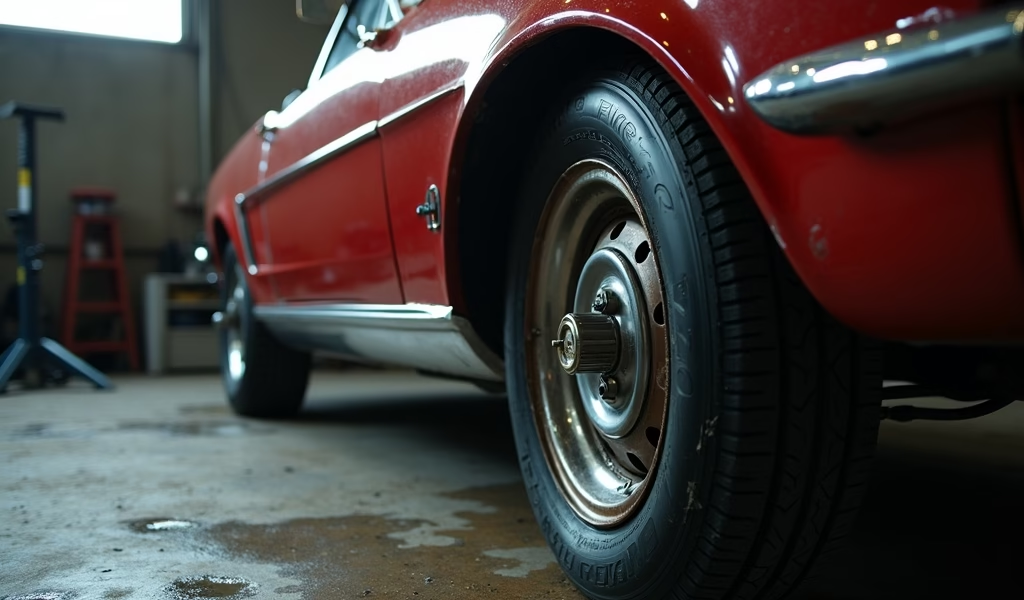Overview
This article provides seven essential tips for ensuring wheel rim width compatibility, emphasizing that proper wheel sizing affects vehicle performance, safety, and tire longevity. Key guidance includes knowing vehicle specifications, understanding tire sizing terminology, calculating safe rim width ranges, considering offset and backspacing, following manufacturer guidelines, and seeking professional installation.
Table of Contents
- Understanding Wheel Rim Width Compatibility
- Why Wheel Rim Width Matters
- Tip 1: Know Your Vehicle’s Specifications
- Tip 2: Understand Tire Sizing Terminology
- Tip 3: Consider the Plus Sizing Method
- Tip 4: Calculate Safe Rim Width Range
- Tip 5: Be Aware of Offset and Backspacing
- Tip 6: Consult Manufacturer Guidelines
- Tip 7: Professional Installation Matters
- Conclusion
- Frequently Asked Questions
Understanding Wheel Rim Width Compatibility
Wheel rim width compatibility is one of those automotive topics that seems straightforward until you dive into the details. As a mechanic with over 15 years of experience, I’ve seen countless vehicles roll into my shop with inappropriate wheel setups that cause premature tire wear, handling problems, and even safety issues. Getting this right isn’t just about aesthetics—though a well-fitted wheel certainly looks better—it’s about ensuring your vehicle performs as intended and keeps you safe on the road.
When we talk about rim width, we’re referring to the distance between the inside edges of the rim flanges (the parts that hold the tire beads in place). This measurement is critical because it directly affects how your tire sits on the wheel and, consequently, how your vehicle handles. Too narrow, and the tire might bulge oddly; too wide, and you risk the tire not seating properly or rubbing against your vehicle’s components.
In this comprehensive guide, I’ll share seven professional tips to help you navigate wheel rim width compatibility with confidence. Whether you’re looking to upgrade your wheels for performance, aesthetics, or simply replacing worn components, these insights will help you make informed decisions and avoid costly mistakes.
Why Wheel Rim Width Matters
Before diving into specific tips, let’s understand why wheel rim width compatibility deserves your attention. When a tire is mounted on a wheel with the appropriate width, it creates the optimal footprint on the road. This footprint affects virtually everything about how your vehicle performs—from braking distance to cornering stability, fuel efficiency, and even the lifespan of your suspension components.
Incorrect rim width can create a cascade of issues. A rim that’s too narrow for your tire will cause the sidewalls to bulge outward, creating less stable handling and increasing the risk of blowouts. Conversely, mounting a tire on an excessively wide rim will stretch the tire sidewalls, potentially reducing their ability to absorb road impacts and making your ride harsh. The bead wire tension specification plays a crucial role here, as improper width can place undue stress on this critical component.
Beyond performance and safety concerns, improper wheel rim width can void your vehicle warranty and insurance coverage in some cases. It may also run afoul of local regulations, potentially leading to failed inspections or even traffic citations in jurisdictions with strict vehicle modification laws.

Tip 1: Know Your Vehicle’s Specifications
Your journey to proper wheel rim width compatibility begins with understanding what your vehicle manufacturer recommends. These specifications aren’t arbitrary—they’re the result of extensive engineering and testing to optimize performance, safety, and comfort.
You can find your vehicle’s recommended wheel specifications in several places:
- Your owner’s manual (typically in the technical specifications section)
- The driver’s side door jamb sticker
- The manufacturer’s website (look for technical specifications or wheel fitment guides)
- Reputable wheel and tire fitment databases online
Take note of not just the recommended rim width, but also the diameter, offset, bolt pattern, and load rating. These specifications work together as a system, and changing one aspect often necessitates adjustments to others to maintain proper compatibility.
For example, a 2018 Honda Accord might specify 7.5-inch wide rims for the standard 17-inch wheels. This doesn’t mean you can only use 7.5-inch wide rims, but it does provide the baseline from which you can determine acceptable alternatives, typically within about 0.5 inches in either direction.
According to Tire Rack’s technical resources, most passenger vehicles have an acceptable rim width range rather than a single specific measurement. Understanding this range gives you flexibility while staying within safe parameters.
Tip 2: Understand Tire Sizing Terminology
Tire sizing can seem like a foreign language at first glance, but understanding this terminology is essential for proper wheel rim width compatibility. Let’s break down a typical tire size: 225/45R17.
- 225: This is the tire width in millimeters, measured from sidewall to sidewall.
- 45: The aspect ratio, which is the sidewall height as a percentage of the width (in this case, the sidewall height is 45% of 225mm).
- R: Indicates radial construction, the most common type for modern tires.
- 17: The wheel diameter in inches.
For wheel rim width compatibility, the most important number is the first one—the tire width. As a general rule of thumb, the ideal rim width (in inches) is approximately 70-75% of the tire width (in millimeters). So for our 225mm tire example, the ideal rim width would be around 6.5-7 inches.
Most tires have a range of acceptable rim widths. For instance, a 225mm tire might safely fit on rims between 6 and 8 inches wide, but would be optimal on a 7-inch rim. The tire tread pattern design will perform best when mounted on a properly sized rim, allowing the tread to make optimal contact with the road.
It’s worth noting that high-performance tires often have different rim width requirements than standard touring tires. Performance tires typically work better with slightly wider rims relative to their width to provide better cornering stability and response.
Tip 3: Consider the Plus Sizing Method
Plus sizing is a popular method for upgrading wheels and tires while maintaining proper overall diameter. This approach involves increasing the wheel diameter while decreasing the tire’s aspect ratio proportionally, keeping the total wheel-and-tire height approximately the same.
For example, if your vehicle came with 16-inch wheels and 205/60R16 tires, a plus-one upgrade might involve 17-inch wheels with 205/55R17 tires. This maintains the same overall diameter but offers benefits like improved handling response due to the shorter, stiffer sidewalls.
When plus sizing, rim width typically increases as well. Following our example, the original 16-inch wheels might be 6.5 inches wide, while the 17-inch replacement wheels could be 7 inches wide. This slight increase is usually acceptable and even beneficial for handling, but there are limits to how much you can safely increase rim width.
The sidewall construction materials play an important role in determining how well a tire can adapt to different rim widths. Modern performance tires typically use advanced materials that provide more flexibility in this regard, but there are still physical limits to consider.
According to NHTSA guidelines, maintaining proper load-carrying capacity is essential when making any wheel or tire changes. Even if the dimensions work out, ensure the new setup meets or exceeds the original load rating.

Tip 4: Calculate Safe Rim Width Range
While the general rule of 70-75% of tire width gives you a starting point, most tire manufacturers provide specific rim width ranges for their products. These ranges indicate the minimum and maximum rim widths that safely accommodate a particular tire size.
If you don’t have access to manufacturer specifications, you can use this practical formula to calculate an acceptable rim width range for most passenger car tires:
- Minimum rim width (inches) ≈ Tire width (mm) ÷ 25.4 × 0.65
- Maximum rim width (inches) ≈ Tire width (mm) ÷ 25.4 × 0.85
For our 225mm tire example:
- Minimum: 225 ÷ 25.4 × 0.65 ≈ 5.8 inches
- Maximum: 225 ÷ 25.4 × 0.85 ≈ 7.5 inches
This gives us a safe range of approximately 6 to 7.5 inches. Keep in mind that the ideal width would be in the middle of this range—around 6.75 to 7 inches for this particular tire.
Remember that these calculations provide guidelines, not hard rules. Factors like tire construction, intended use, and vehicle-specific considerations can all influence the ideal rim width. When in doubt, consult with a tire professional or the manufacturer directly.
The European Tyre and Rim Technical Organisation (ETRTO) publishes standards for tire and rim compatibility that are widely respected in the automotive industry. Their technical datasheets provide authoritative guidance on acceptable rim widths for specific tire sizes.
Tip 5: Be Aware of Offset and Backspacing
While rim width is crucial, it’s not the only dimensional factor that affects wheel compatibility. Wheel offset and backspacing determine how the wheel sits relative to your vehicle’s suspension and body components.
Offset is measured in millimeters and can be positive, zero, or negative:
- Positive offset: The mounting surface is toward the outer face of the wheel (common in front-wheel-drive vehicles)
- Zero offset: The mounting surface aligns with the centerline of the wheel
- Negative offset: The mounting surface is toward the inner side of the wheel (often seen in trucks and some performance applications)
Backspacing is the measurement from the mounting surface to the inner edge of the wheel. It’s directly related to offset but is measured in inches and provides a more intuitive understanding of how the wheel fits relative to the suspension components.
Even if a wheel has the correct width, an incorrect offset or backspacing can cause the wheel to rub against brake components, suspension parts, or fenders. It can also negatively affect steering geometry and bearing load, potentially leading to premature wear or failure of these components.
When changing wheel width, offset adjustments are often necessary to maintain proper fitment. As a general rule, for every half-inch increase in wheel width, you may need to decrease the offset by about 6-7mm to maintain similar clearances and vehicle track width.
Tip 6: Consult Manufacturer Guidelines
While the formulas and rules of thumb I’ve shared are helpful starting points, nothing beats the specific guidance provided by manufacturers. Tire makers invest heavily in testing to determine exactly which rim widths work best with their products.
Most major tire manufacturers publish fitment guides that specify the approved rim width range for each tire they produce. These guides often include additional information like the optimal rim width for best performance and the minimum air pressure required for different load conditions.
Similarly, vehicle manufacturers establish wheel specifications based on extensive testing. Deviating too far from these specifications can compromise safety systems like ABS and stability control, which are calibrated for specific wheel and tire combinations.
If you’re considering aftermarket wheels, reputable wheel manufacturers typically provide detailed fitment information for specific vehicle makes and models. Many offer “guaranteed fit” programs that take the guesswork out of compatibility.
Remember that manufacturer guidelines aren’t just recommendations—they’re often requirements for maintaining warranty coverage. Straying too far from these specifications might save money upfront but could cost significantly more down the road if problems arise.
Tip 7: Professional Installation Matters
Even with perfect compatibility on paper, proper installation is essential for wheel rim width compatibility in practice. A professional installer brings both the specialized equipment and the expertise needed to ensure everything fits and functions correctly.
Professional installation includes several critical steps:
- Proper torquing of lug nuts to manufacturer specifications
- Correct mounting and balancing procedures
- Verification of clearances throughout the full range of suspension travel
- Inspection of related components like brake lines and suspension parts
- Setting proper tire pressures based on the specific wheel/tire combination
Many tire shops also perform a road test after installation to check for vibrations, pulling, or unusual handling characteristics that might indicate compatibility issues. This real-world verification can identify problems that might not be obvious when the vehicle is stationary.
While it might be tempting to save money with DIY installation, the specialized equipment required for proper mounting and balancing is expensive and requires training to use correctly. The cost of professional installation is typically modest compared to the potential expense of dealing with problems caused by improper installation.
Conclusion
Wheel rim width compatibility might seem like a minor technical detail, but it has far-reaching implications for your vehicle’s performance, safety, and reliability. By following these seven professional tips, you can make informed decisions about wheel and tire combinations that enhance your driving experience without compromising safety.
Remember that proper wheel rim width is just one piece of the compatibility puzzle. Diameter, offset, bolt pattern, load rating, and clearance considerations all work together to determine whether a particular wheel will work well on your vehicle.
When in doubt, consult with professionals or refer to manufacturer specifications. The small investment in research or professional advice can prevent costly mistakes and ensure you get the performance and aesthetics you want from your wheel and tire setup.
Whether you’re looking for improved performance, updated styling, or simply replacing worn components, understanding wheel rim width compatibility empowers you to make choices that enhance your vehicle rather than compromise it. Your vehicle—and your safety—deserve nothing less than the perfect fit.
Frequently Asked Questions
Can I put wider tires on my stock rims?
Yes, but only within limits. Most rims can safely accommodate tires up to 20mm wider than the original specification, but check manufacturer guidelines first.
What happens if I use a rim that’s too narrow for my tire?
The tire sidewalls will bulge outward, causing unstable handling and increasing blowout risk. This can also lead to accelerated and uneven tire wear.
Does wheel width affect fuel economy?
Yes, wider wheels and tires typically increase rolling resistance and weight, reducing fuel economy. The effect is usually small (1-2 mpg) but noticeable over time.
How much does wheel width affect handling?
Significantly—wider wheels generally improve cornering grip and stability but may reduce straight-line comfort. The sweet spot depends on your driving priorities and vehicle design.
Will changing my wheel width affect my speedometer accuracy?
Not if you maintain the same overall tire diameter. Changes in total diameter (rim + tire) affect speedometer readings, while width changes alone generally don’t.

